© Copyright 2006 Fortinet Incorporated. All rights reserved.
Products mentioned in this document are trademarks or registered trade-
marks of their respective holders.
Regulatory Compliance
FCC Class A Part 15 CSA/CUS
5 July 2006
Checking the Package Contents
Planning the Configuration
Esc Enter
HADMZINTERNAL EXTERNAL
1 2 3 4 5 6 7 8
Power cable connects to power outlet
Optional null modem cable connects
to serial port on management computer
Straight-through Ethernet cable connects to Internet (public switch, router or modem)
Straight-through Ethernet cable connects to DMZ network
Straight-through Ethernet cable connects to another FortiGate-500 for HA
Straight-through Ethernet cable connects
to LAN or switch on internal network
Crossover Ethernet cable connects to
management computer on internal network
or
Straight-through Ethernet cables connect to other networks
Connector Type Speed Protocol Description
Internal RJ-45 10/100 Base-T Ethernet Connection to the internal network.
External RJ-45 10/100 Base-T Ethernet Connection to the Internet.
DMZ RJ-45 10/100 Base-T Ethernet Optional connection to a DMZ network.
HA RJ-45 10/100 Base-T Ethernet Optional connection to other FortiGate-500 units for
high availability (HA). For details, see the Documen-
tation CD-ROM.
1 to 8 RJ-45 10/100 Base-T Ethernet Optional connections to other networks.
Console DB-9 9600 Bps RS-232 Optional connection to the management computer.
Provides access to the command line interface
(CLI).
USB USB USB Optional connection for the FortiUSB key, modem or
backup operation.
Place the unit on a stable surface. It requires 1.5 inches (3.75 cm) clearance above and
on each side to allow for cooling.
Make sure the power switch on the back of the unit is turned off before connecting the
power and network cables.
The following is displayed on the LCD when the unit is up and running:
Menu [ Fortigat -> ]
NAT, Standalone
•
•
•
Connect the FortiGate unit to a power outlet and to the internal and external networks.
Before beginning to congure the FortiGate unit, you need to plan how to integrate the unit into your network. Your conguration plan depends on the operating mode you select: NAT/Route
mode (the default) or Transparent mode.
NAT/Route mode
In NAT/Route mode, each FortiGate unit is visible to the network that it is connected to. All of
its interfaces are on different subnets. Each interface that is connected to a network must be
congured with an IP
address that is valid for
that network.
You would typically use
NAT/Route mode when the
FortiGate unit is deployed
as a gateway between
private and public
networks. In its default
NAT/Route mode congu-
ration, the unit functions as
a rewall. Firewall policies
control communications
through the FortiGate unit.
No trafc can pass through the FortiGate unit until you add rewall policies. In NAT/Route
mode, rewall policies can operate in NAT mode or in Route mode. In NAT mode, the
FortiGate unit performs network address translation before IP packets are sent to the
destination network. In Route mode, no translation takes place.
Transparent mode
In Transparent mode, the FortiGate unit is invisible to the network. All of its interfaces are on
the same subnet. You only have to congure a management IP address so that you can make
conguration changes.
You would typically use the
FortiGate unit in Transparent
mode on a private network
behind an existing rewall or
behind a router. In its default
Transparent mode conguration,
the unit functions as a rewall.
No trafc can pass through the
FortiGate unit until you add
rewall policies.
You can connect up to four network segments to the FortiGate unit to control trafc between
these network segments.
Internet
Router
10.10.10.1
Management IP
Internal
Internal Network
10.10.10.3
External
Gateway to public network
204.23.1.5 10.10.10.2
Transparent mode policies
controlling traffic between
internal and external networks.
Refer to the Documentation CD-ROM for information on how to control trafc, and how to congure HA, antivirus protection, FortiGuard, Web content ltering, Spam ltering,
intrusion prevention (IPS), and virtual private networking (VPN).
FortiGate-500
01-30002-0037-20060705
LED State Description
Power
Green The FortiGate unit is on.
Off The FortiGate unit is off.
Internal
External
DMZ
HA
1 to 8
Amber The correct cable is in use and the connected
equipment has power.
Flashing Amber Network activity at this interface.
Red Ports 5 and 6.
Green The interface is connected at 100Mbps.
Off No link established.
Router
Internet
DMZ
network
DMZ
10.10.10.1
10.10.10.2
NAT mode policies
controlling traffic between
internal and external networks
Route mode policies
controlling traffic between
internal networks
External
204.23.1.5
Internal
network
192.168.1.3
Internal
192.168.1.99
Choosing a Configuration Tool
Web-based manager
The FortiGate web-based manager is an easy to use management tool. Use it to congure
the administrator password, the interface and default gateway addresses, and the DNS
server addresses.
Requirements:
An Ethernet connection between the FortiGate unit and management computer.
Internet Explorer 6.0 or higher on the management computer.
•
•
Command Line Interface (CLI)
The CLI is a full-featured management tool. Use it to congure the administrator password,
the interface addresses, the default gateway address, and the DNS server addresses. To
congure advanced settings, see the Documentation CD-ROM.
Requirements:
The DB-9 serial connection between the FortiGate unit and management computer.
A terminal emulation application (HyperTerminal for Windows) on the management
computer.
•
•
Esc Enter
HADMZ
INTERNAL
EXTERNAL 1 2 3 4 5 6 7 8
Front
Back
Esc Enter
HADMZ
INTERNAL
EXTERNAL 1 2 3 4 5 6 7 8
1 to 8
Interface
LCD Control
Buttons
Internal,External,DMZ
HA Interface
Power
Light
RS-232
Serial
Connection
Removable
Hard Drive
Power
Connection
Power
Switch
Power Cable
Rack-Mount Brackets
Null-Modem Cable
(RS-232)
Ethernet Cables:
Orange - Crossover
Grey - Straight-through
Documentation
FortiGat e-500
Copyright 200 6 Fortinet Incorporate d. All righ ts reserved .
Trademarks
Products ment ioned in th is document are tradem arks.
Q ui c k St a rt G ui d e
Esc Enter
HADMZ
INTERNAL
EXTERNAL 1 2 3 4 5 6 7 8



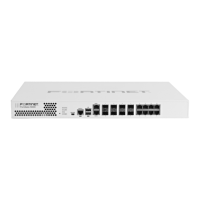

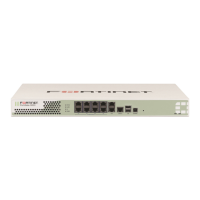
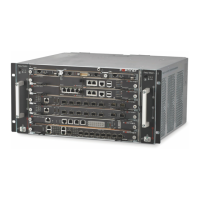



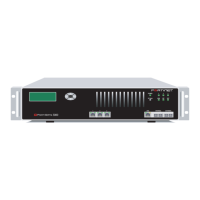
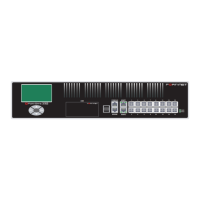
